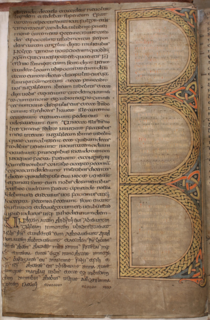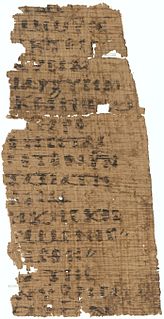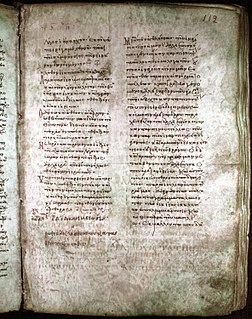 W
WThe Ashburnham Pentateuch is a late 6th- or early 7th-century Latin illuminated manuscript of the Pentateuch. Although it originally contained all five books of the Pentateuch, it is now missing the whole of Deuteronomy as well as sections of the other five books.
 W
WThe Book of Durrow is a medieval illuminated manuscript gospel book in the Insular script style. It was probably created between 650 and 700. The place of creation may perhaps have been Durrow Abbey in Ireland or a monastery in Northumbria in northeastern England or perhaps Iona Abbey in western Scotland—the place of origin has been debated by historians for decades without a consensus emerging. The Book of Durrow was probably at Durrow Abbey by 916. Today it is in the Library of Trinity College Dublin.
 W
WThe Cathach of St. Columba is a late 6th century Insular psalter.
 W
WCodex Usserianus Primus is an early 7th-century Old Latin Gospel Book. It is dated palaeographically to the 6th or 7th century. It is designated by r.
 W
WThe Codices Ambrosiani A–E are five biblical manuscripts dating to the 6th–11th centuries CE now in the Biblioteca Ambrosiana in Milan. They are written by different hands and in different alphabets. The codices contain scattered passages from the Old Testament (Nehemiah) and the New Testament, as well as some commentaries known as Skeireins, rare survivals in the Gothic language.Codex Ambrosianus A contains parts of the Epistles and the Gothic Calendar. It consists of 204 pages, of which 190 are legible, 2 are illegible and 12 are empty. Codex Ambrosianus B contains parts of the Epistles, and consists of 156 pages, of which two are empty. The Codex Ambrosianus B.21 is written in Syriac language and script. It is the basis of the Leiden Peshitta critical edition of the Peshitta Old Testament. Nominally dated to the 7th century, the consensus is that it is not older than the 6th century. It contains Apocrypha, 4 Ezra, 2 Baruch, 3 and 4 Maccabees, and a part of Josephus on the Maccabees. Codex Ambrosianus C consists of two leaves and contains fragments of chapters 25 to 27 of the Gospel of Matthew.
 W
WThe Durham Gospels is a very incomplete late 7th century insular Gospel Book, now kept in the Durham Cathedral Dean and Chapter Library. A single folio of this manuscript is now in Magdalene College, Cambridge. Only two of the fully decorated pages survive: a Crucifixion and the initial to John, and both of these are in poor condition. There were probably originally evangelist portraits and carpet pages, as in other Insular Gospel books conceived on a similar scale. The book was produced at Lindisfarne and brought to Durham when the monks of Lindisfarne removed to Durham because of Viking attacks. The Durham Gospels were written by the same scribe that wrote the Echternach Gospels.
 W
WThe Echternach Gospels were produced, presumably, at Lindisfarne Abbey in Northumbria around the year 690. This location was very significant for the production of Insular manuscripts, such as the Durham Gospels and the Lindisfarne Gospels. The scribe of the Durham Gospels is believed to have created the Echternach Gospels as well. The Echternach Gospels are now in the collection of France’s Bibliothèque Nationale in Paris.
 W
WDurham Cathedral Library, Manuscript A.II.10. is a fragmentary seventh century Insular Gospel Book, produced in Lindisfarne c. 650. Only seven leaves of the book survive, bound in three separate volumes in the Durham Cathedral Dean and Chapter Library. Although this book is fragmentary, it is the earliest surviving example in the series of lavish Insular Gospel Books which includes the Book of Durrow, the Lindisfarne Gospels, the St. Teilo Gospels and the Book of Kells.
 W
WThe Muratorian fragment, also known as the Muratorian Canon or Canon Muratori, is a copy of perhaps the oldest known list of most of the books of the New Testament. The fragment, consisting of 85 lines, is a 7th-century Latin manuscript bound in a 7th- or 8th-century codex from the library of Columbanus's monastery at Bobbio Abbey; it contains features suggesting it is a translation from a Greek original written about 170 or as late as the 4th century. Both the degraded condition of the manuscript and the poor Latin in which it was written have made it difficult to translate. The beginning of the fragment is missing, and it ends abruptly. The fragment consists of all that remains of a section of a list of all the works that were accepted as canonical by the churches known to its original compiler. It was discovered in the Ambrosian Library in Milan by Father Ludovico Antonio Muratori (1672–1750), the most famous Italian historian of his generation, and published in 1740.
 W
WPapyrus 44, signed by 44, is an early copy of the New Testament in Greek. It is a papyrus manuscript of the Gospel of Matthew. It contains Matt. 17:1-3.6-7; 18:15-17.19; 25:8-10. Fragments of the Gospel of John formerly known as Papyrus 44b have been reclassified as Papyrus 128. The manuscript paleographically has been assigned to the 6th or 7th century.
 W
WPapyrus 74, designated by 74, is a copy of the New Testament in Greek. It is a papyrus manuscript of the Acts of the Apostles and Catholic epistles with lacunae. The manuscript paleographically had been assigned to the 7th century.
 W
WPapyrus 79, designated by 79, is a copy of the New Testament in Greek. It is a papyrus manuscript of the Epistle to the Hebrews. The surviving texts of Hebrews are verses 10:10-12,28-30.
 W
WPapyrus 128, designated by 𝔓128, is a copy of a small part of the New Testament in Greek. It is a papyrus manuscript of the Gospel of John, containing verses 9:3-4; 12:16-18. The manuscript paleographically has been assigned to the 6th or 7th century.
 W
WThe Syriac Bible of Paris is an illuminated Bible written in Syriac. It dates to 6th or 7th century. It is believed to have been made in northern Mesopotamia. The manuscript has 246 extant folios. Large sections of text and the accompanying illustrations are missing. The folios are 312 by 230 mm. For reasons of economy, the text is written in three columns.
 W
WThe siglum Taylor-Schechter 12.182 designates a manuscript written on parchment in codex form. This is a palimpsest of a copy of Origen's work called the Hexapla. This is a manuscript dated to 7th-century C.E. This manuscript is the oldest of the hexapla. The hexapla was completed before the year 240 C.E.
 W
WUncial 097, α 1003 (Soden), is a Greek uncial manuscript of the New Testament, dated palaeographically to the 7th-century.
 W
WUncial 0183, is a Greek uncial manuscript of the New Testament, dated palaeographically to the 7th century.
 W
WUncial 0209, is a Greek uncial manuscript of the New Testament, dated palaeographically to the 7th-century.
 W
WUncial 0210, is a Greek uncial manuscript of the New Testament, dated palaeographically to the 7th century.